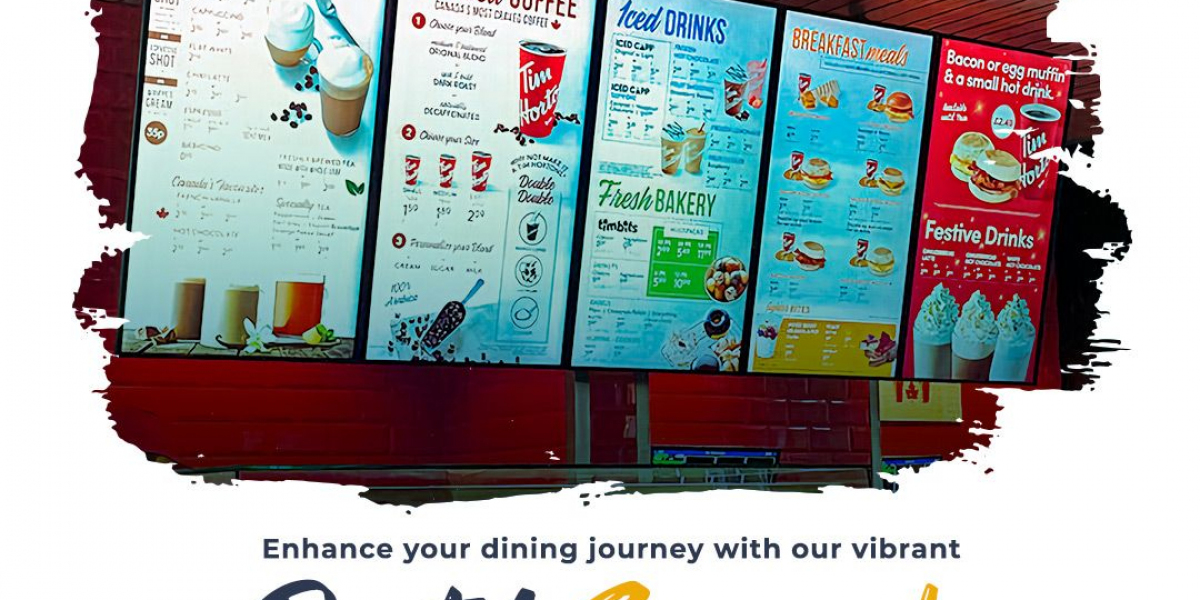As the restaurant industry becomes more competitive and customer expectations rise, businesses are increasingly turning to technology to stand out. Digital signage has emerged as one of the most impactful tools for enhancing the customer experience, streamlining operations, and driving sales. Whether in fine dining establishments or fast-food chains, digital signage is transforming the way restaurants interact with their patrons. Here's why digital signage is becoming an essential component for restaurants of all sizes.
1. Improved Visual Appeal and Engagement
One of the most significant advantages of digital signage is its ability to capture attention through dynamic visuals. Traditional static menus or printed posters can often go unnoticed, but a bright, high-resolution digital screen filled with engaging images, videos, or animations can quickly draw the eye.
Restaurants can use digital signage to:
- Display digital menus with crisp, colorful images of food and beverages.
- Highlight special offers, promotions, or limited-time items.
- Provide custom content, such as behind-the-scenes footage of food preparation, or themed events.
The flexibility of restaurant digital signage allows restaurants to continuously update and adapt their visuals, making the dining experience more exciting and personalized for customers.
2. Streamlined Menu Management and Real-Time Updates
Unlike traditional printed menus, digital signage can be easily updated in real time. This is particularly useful for restaurants with constantly changing menus, daily specials, or limited-time offers. Instead of spending time and money printing new materials, restaurant owners can adjust their digital displays instantly.
For example:
- Price changes or item availability can be reflected immediately.
- Seasonal items or promotions can be updated across all locations with the click of a button.
- Out-of-stock notifications can be quickly added to avoid customer frustration.
This ability to quickly adapt to changes ensures that menus remain accurate, visually appealing, and relevant, all while saving time and reducing operational costs.
3. Increased Sales Through Upselling and Cross-Selling
Digital signage is a powerful marketing tool that can drive higher sales through upselling and cross-selling. By using visually appealing displays, restaurants can promote high-margin items, combo deals, or recommend side dishes and desserts. These promotions can be strategically timed to boost sales during peak hours or to complement certain meal choices.
For example, when a customer is deciding on their main course, a digital display might suggest adding a popular side dish or beverage, or feature a dessert with an enticing image. This approach increases the likelihood of customers purchasing additional items, which can significantly raise the average order value.
4. Enhanced Customer Experience with Interactive Elements
Interactive digital signage can take customer engagement to the next level by allowing diners to actively participate in the experience. Touchscreen displays and self-order kiosks give customers the freedom to browse the menu at their own pace, customize their orders, and even place them without waiting for staff.
This interactive functionality is particularly beneficial for quick-service restaurants (QSRs), where customers appreciate convenience and speed. By allowing customers to self-serve, these restaurants can reduce wait times, improve order accuracy, and free up staff to focus on delivering food or enhancing customer service.
5. Cost-Efficient and Environmentally Friendly
Adopting digital signage is not only a smart business decision but also an environmentally responsible one. By reducing the need for paper menus, posters, and printed materials, restaurants can minimize waste and lower their environmental impact. Additionally, while the initial investment in digital screens may seem high, the long-term savings in printing costs and labor make it a cost-efficient solution.
Moreover, many digital signage systems are designed for energy efficiency, using LED displays that consume less power. This reduces both operational costs and the restaurant’s carbon footprint.
6. Branding and Personalization
Digital signage offers an unparalleled opportunity for restaurants to reinforce their brand identity. With customizable content, restaurants can create displays that reflect their unique style, colors, and theme. This branding can be consistent across multiple locations, helping build a cohesive image.
Restaurants can also use digital signage to create personalized experiences for their customers. By integrating with customer loyalty programs or mobile apps, digital signage can display personalized offers, birthday greetings, or even suggest meals based on past preferences. This personalized touch helps to strengthen the customer-restaurant relationship and encourages repeat visits.
7. Effective Communication and Entertainment
Beyond menus and promotions, digital signage is a versatile tool for communication. Restaurants can use screens to share important information such as:
- Safety measures and sanitization protocols.
- Special event announcements or upcoming entertainment.
- Customer reviews and social media feeds.
Restaurants with a focus on entertainment can even use digital signage to display live sports, music videos, or customer-generated content, providing an engaging atmosphere that keeps customers entertained while they wait or dine.
8. Future Trends and Innovations
As technology continues to evolve, so does the potential for digital signage in restaurants. Some emerging trends include:
- AI-driven displays: Using artificial intelligence, digital signage could analyze customer preferences and suggest personalized meal recommendations in real time.
- Augmented reality (AR): Restaurants could incorporate AR elements, allowing customers to visualize how a dish would look before ordering it.
- Interactive games: To entertain customers, especially in family-friendly restaurants, digital signage could feature interactive games, quizzes, or loyalty rewards systems that enhance the dining experience.
These advancements will likely continue to reshape the way restaurants utilize digital signage, making it an even more integral part of the dining experience.
Conclusion
The adoption of digital signage software in restaurants is more than just a trend; it represents a fundamental shift in how businesses interact with their customers. By providing a dynamic, customizable, and engaging platform, digital signage allows restaurants to enhance customer satisfaction, increase sales, and improve operational efficiency.
Whether it's displaying menus, promoting offers, or creating interactive experiences, digital signage offers countless possibilities for restaurants to differentiate themselves in a crowded market. As the technology evolves, it will undoubtedly continue to play a pivotal role in shaping the future of dining experiences.








